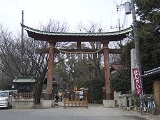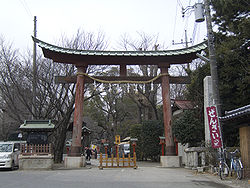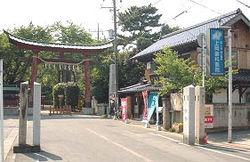
Washinomiya Shrine
Encyclopedia

Kanto region
The is a geographical area of Honshu, the largest island of Japan. The region includes the Greater Tokyo Area and encompasses seven prefectures: Gunma, Tochigi, Ibaraki, Saitama, Tokyo, Chiba, and Kanagawa. Within its boundaries, slightly more than 40 percent of the land area is the Kantō Plain....
, located in Kuki
Kuki, Saitama
is a city located in Saitama, Japan.As of May 1, 2011, the city has an estimated population of 156,613, with a household number of 61,071, and the density of 1,900.64 persons per km²...
, Saitama
Saitama Prefecture
is a prefecture of Japan located in the Kantō region of the island of Honshu. The capital is the city of Saitama.This prefecture is part of the Greater Tokyo Area, and most of Saitama's cities can be described as suburbs of Tokyo, to which a large amount of residents commute each day.- History...
(Formerly Washimiya
Washimiya, Saitama
was a town located in Kitakatsushika District, Saitama, Japan.As of 2003, the town had an estimated population of 33,739 and a density of 2,427.27 persons per km²...
), Japan
Japan
Japan is an island nation in East Asia. Located in the Pacific Ocean, it lies to the east of the Sea of Japan, China, North Korea, South Korea and Russia, stretching from the Sea of Okhotsk in the north to the East China Sea and Taiwan in the south...
.
History
The oldest record of the shrine was found in the Azuma KagamiAzuma Kagami
The , or "mirror of the east", is a Japanese medieval text that chronicles events of the Kamakura Shogunate from Minamoto no Yoritomo's rebellion against the Taira clan in Izokuni of 1180 to Munetaka Shinnō and his return to Kyoto in 1266...
, the official historical record for the Kamakura Shogunate
Kamakura shogunate
The Kamakura shogunate was a military dictatorship in Japan headed by the shoguns from 1185 to 1333. It was based in Kamakura. The Kamakura period draws its name from the capital of the shogunate...
. It had the patronage of the Imperial family, and even Shogun Tokugawa Ieyasu
Tokugawa Ieyasu
was the founder and first shogun of the Tokugawa shogunate of Japan , which ruled from the Battle of Sekigahara in 1600 until the Meiji Restoration in 1868. Ieyasu seized power in 1600, received appointment as shogun in 1603, abdicated from office in 1605, but...
. Various folk-culture and performing art events, including the Saibara-Kagura Festival are held here. Its traditional dance
Kagura
- Fictional characters :*Kagura Tsuchimiya, the protagonist of Ga-rei*Kagura, an InuYasha character*Kagura Sohma , a Fruits Basket character*Kagura, an Azumanga Daioh character*Ten'nōzu Kagura, a Speed Grapher character...
handed down through generations has been designated as a national intangible folk-culture asset. The shrine also houses several ancient relics.
During the New Year season, the shrine receives no fewer than 100,000 visitors.
Otaku pilgrimages

Newtype (magazine)
is a monthly magazine publication originating from Japan, covering anime and manga . It was launched by publishing company Kadokawa Shoten on March 8, 1985 with its April issue, and has since seen regular release on the 10th of every month in its home country...
magazine ran an article on the various locales featuring in the popular anime and manga Lucky Star, and provided directions on how to reach these places from the otaku
Otaku
is a Japanese term used to refer to people with obsessive interests, particularly anime, manga or video games.- Etymology :Otaku is derived from a Japanese term for another's house or family , which is also used as an honorific second-person pronoun...
hotspot Akihabara
Akihabara
, also known as , is an area of Tokyo, Japan. It is located less than five minutes by rail from Tokyo Station. Its name is frequently shortened to in Japan...
, including the Washinomiya Shrine which had its torii
Torii
A is a traditional Japanese gate most commonly found at the entrance of or within a Shinto shrine, where it symbolically marks the transition from the profane to the sacred...
shown in the opening sequence and featured the Hiiragi sisters working as miko
Miko
is a Japanese term that anciently meant a "female shaman, spirit medium" who conveyed oracles from kami , and currently means a "shrine maiden; virgin consecrated to a deity" who serves at Shinto shrines.-Word:...
in the anime.
Shortly afterwards, massive otaku pilgrimages to the shrine became the most widely reported consequence of the feature's publication. It became a place teeming with photographers trying to replicate scenes from the anime, cosplay
Cosplay
, short for "costume play", is a type of performance art in which participants don costumes and accessories to represent a specific character or idea. Characters are often drawn from popular fiction in Japan, but recent trends have included American cartoons and science fiction...
ers wandering around, and prayer plaques
Ema (Shinto)
are small wooden plaques on which Shinto worshippers write their prayers or wishes. The ema are then left hanging up at the shrine, where the kami receive them. They bear various pictures, often of animals or other Shinto imagery, and many have the word gan'i , meaning "wish", written along the side...
ridden with anime drawings and strange prayers like "Konata is my wife".
The head of the shrine raised concerns that the visitors were worshipping "deities" other than the shrine's own. The locals were divided on the situation, with some suggesting that it was good for the shrine to have so many worshippers, and some being concerned about the town's security. The visiting otakus, although considered unusual, were generally described as being well-mannered. Eventually, many local residents embraced the otaku, with some profiting from the new traffic and influx of people. This social phenomenon
Social phenomenon
Social phenomena include all behavior which influences or is influenced by organisms sufficiently alive to respond to one another.-See also:*Forms of activity and interpersonal relations*List of sociology topics*Social fact-References:...
was subsequently satirized in the twenty-first episode of the anime.
On December 2, 2007, Kagami Yoshimizu and 4 cast members of Lucky Star held a brunch and "official" visit of the shrine. A highlight of the visit was a guided tour by the voice actors of the "Hiiragi sisters" (Emiri Kato
Emiri Kato
is a female Japanese voice actress working for 81 Produce.-Anime:*Akane-Iro ni Somaru Saka *Angel Beats! *Arc Rise Fantasia *Ad Lib Anime Kenkusho is a female Japanese voice actress working for 81 Produce.-Anime:*Akane-Iro ni Somaru Saka (Karen Ayanokouji)*Angel Beats! (Sekine)*Arc Rise Fantasia...
and Kaori Fukuhara
Kaori Fukuhara
is a female Japanese voice actress from Chiba, Japan.Aside from voice acting, she also sang on the music group Bohemian Quarter's album "Blister Pack Voices".- TV anime :2005*Animal Yokocho is a female Japanese voice actress from Chiba, Japan.Aside from voice acting, she also sang on the music...
) leading the other two VA's and fans around the real shrine.

